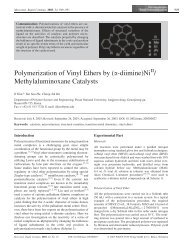Schiff-Base Complexes and their Application to Styrene ...
Schiff-Base Complexes and their Application to Styrene ...
Schiff-Base Complexes and their Application to Styrene ...
You also want an ePaper? Increase the reach of your titles
YUMPU automatically turns print PDFs into web optimized ePapers that Google loves.
1322 I. Kim, Y. S. Ha, D. F. Zhang, C. Ha, U. Leemers, as well as in the control of polymer properties. Thediscovery of metallocene catalysts opened up the possibilityof stereochemical control in olefin polymerization at themolecular level, thus producing polymers with new microstructures(e.g., isotactic, syndiotactic, <strong>and</strong> stereoblock)resulting from the design of the catalyst. [20] Most remarkableis the recent development of syndiospecific styrenepolymerization. In order <strong>to</strong> check the possibility of usingthe titanium complexes bearing tetradentate salen lig<strong>and</strong>sas procatalysts for stereospecific polymerization, we carriedout styrene polymerization with compounds 2a–eat various temperatures. In a typical procedure, <strong>to</strong>luene(5 mL), styrene (5 mL), MAO ([Al]/[Ti] ratio of 200 <strong>to</strong>1 000) <strong>and</strong> procatalyst (25.6 mmol) were charged in<strong>to</strong> a drySchlenk tube (50 mL) equipped with a magnetic stirrer,in this order, under nitrogen flow. The polymerization wascarried out at constant temperature for five hours.Table 1 shows the results of styrene polymerization. Thechange of the bulkiness of the aryl ring has an influence onthe syndiotacticity <strong>and</strong> melting point. The catalytic activity(as an average rate of polymerization R p,avg ) is in the rangebetween 10.3 10 3 <strong>and</strong> 19.2 10 3 (g-PS)(mol-Ti) 1 h 1with an [Al]/[Ti] ratio of 500 at 70 8C. Compound 2d, whichbears an aryl group with bulky tBu substituents, showshigher activity than the sterically less hindered compound2a. All compounds bearing an alkyl substituent in the orthoposition of the aryl ring show quite high syndiotacticity;however, compound 2a yields low-molecular-weight atacticpolystyrene (PS) with no melting peak. The stericallymore hindered compounds 2b <strong>and</strong> 2d yield PS with highersyndiotacticity than compounds 2c <strong>and</strong> 2e. These resultsdemonstrate that the presence of bulky substituents at theortho position of the aryl ring in titanium salen <strong>and</strong> itsderivatives is an important condition <strong>to</strong> obtain a stereoregularpolystyrene with high molecular weight. It isassumed that the conjugate effect <strong>and</strong> the flexibility of thelig<strong>and</strong>s in coordination structures are important fac<strong>to</strong>rsaffecting the catalytic activity of the salen-type titaniumcomplexes. Two conjugate parts (–N CHAr) are separatedby a CH 2 CH 2 bridge in the salen lig<strong>and</strong>. Accordingly, thedesolvation of the titanium salen complexes in <strong>to</strong>luene leads<strong>to</strong> six-coordinate complexes, which might rearrange <strong>to</strong> anonplanar coordination geometry of the four donor a<strong>to</strong>msin the salen lig<strong>and</strong> with a cis-N, cis-O, <strong>and</strong> cis-Cl arrangement,just like the zirconium acen complex [ZrCl 2 (acen)][acen ¼ N,N 0 -ethylenebis(acetylace<strong>to</strong>neimina<strong>to</strong>)], whichhas been structurally characterized. [8] We are investigatingthe effect of other electron withdrawing or electron donatingsubstituents on the activity <strong>and</strong> stereoregularity of styrenepolymerization with the same system.Polymerizations with compounds 2b <strong>and</strong> 2d under differentreaction conditions, such as [Al]/[Ti] ratio <strong>and</strong> temperature,show that the catalytic activity increases as thetemperature <strong>and</strong> [Al]/[Ti] ratio increase (Table 1); the syndiotacticity<strong>and</strong> molecular weight of the polymer decreaseas the temperature increases, as expected. An increase ofMAO concentration has almost no influence on the syndiotacticity(see run nos. 8 <strong>to</strong> 10 in Table 1) within our experimentalrange; however, the M v value decreases as MAOconcentration increases.Conclusions[TiCl 2 (salen)] <strong>and</strong> its derivatives having the formula[TiCl 2 (L)] [L ¼ salen(tBu), salen(di-Me), salen(di-tBu),salen(Me)] were synthesized in high yield by reacting the<strong>Schiff</strong>-base lig<strong>and</strong>s with TiCl 4 . The titanium centers ofTable 1. Experimental results for styrene polymerizations with chlorotitanium(IV) <strong>Schiff</strong>-base complexes in combination with MAO.Polymerization conditions: [Ti] ¼ 25.6 10 6 M, styrene ¼ 5 mL, <strong>to</strong>luene ¼ 5 mL, time ¼ 5h.Run no. Compd. Temp. [Al]/[Ti] Yield R p,avg 10 3a) S.I. b) T mc)M v 10 5d)8C mol/mol g % 8C1 2a 70 500 1.32 10.3 25.0 n.d. 0.182 2b 30 500 0.47 3.7 86.3 267 3.333 2b 50 500 0.63 4.9 83.7 263 2.164 2b 70 500 1.36 10.6 80.7 262 1.655 2c 70 500 1.51 11.8 74.7 261 1.336 2d 30 500 0.77 6.0 87.3 270 3.857 2d 50 500 1.72 13.4 82.5 264 1.328 2d 70 500 2.16 16.9 79.5 262 1.269 2d 70 200 1.51 11.8 76.3 265 1.7310 2d 70 1000 2.46 19.2 74.5 263 0.8511 2e 70 500 1.70 13.3 75.6 256 0.64a) Average rate of polymerization in g-PS (mol-Ti) 1 (hr) 1 .b) Syndiotactic index measured by 2-butanone insoluble parts.c) Melting temperature of the samples of 2-butanone insoluble parts measured by DSC at a heating rate of 10 8C/min.d) Viscosity-average molecular weight measured with an Ubbelhode viscometer.Macromol. Rapid Commun. 2004, 25, 1319–1323 www.mrc-journal.de ß 2004 WILEY-VCH Verlag GmbH & Co. KGaA, Weinheim





